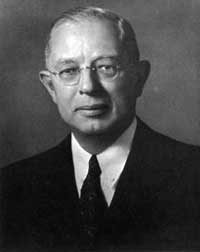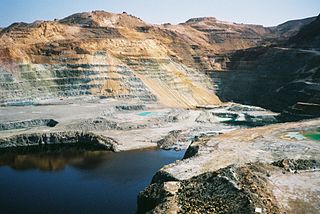Freeport-McMoRan Inc., often called Freeport, is an American mining company based in the Freeport-McMoRan Center, in Phoenix, Arizona. The company is the world's largest producer of molybdenum, a major copper producer and operates the world's largest gold mine, the Grasberg mine in Papua, Indonesia.

Copper extraction refers to the methods used to obtain copper from its ores. The conversion of copper ores consists of a series of physical, chemical and electrochemical processes. Methods have evolved and vary with country depending on the ore source, local environmental regulations, and other factors.

The National Copper Corporation of Chile, abbreviated as Codelco, is a Chilean state-owned copper mining company. It was formed in 1976 from foreign-owned copper companies that were nationalised in 1971.

Kennecott Utah Copper LLC (KUC), a division of Rio Tinto Group, is a mining, smelting, and refining company. Its corporate headquarters are located in South Jordan, Utah. Kennecott operates the Bingham Canyon Mine, one of the largest open-pit copper mines in the world in Bingham Canyon, Salt Lake County, Utah. The company was first formed in 1898 as the Boston Consolidated Mining Company. The current corporation was formed in 1989. The mine and associated smelter produce 1% of the world's copper.

Harvey Seeley Mudd was a mining engineer and founder, investor, and president of Cyprus Mines Corporation, a Los Angeles–based international enterprise that operated copper mines on the island of Cyprus.
Seeley Wintersmith Mudd (1861–1926) was an American mining engineer.
Mount Isa Mines Limited ("MIM") operates the Mount Isa copper, lead, zinc and silver mines near Mount Isa, Queensland, Australia as part of the Glencore group of companies. For a brief period in 1980, MIM was Australia's largest company. It has pioneered several significant mining industry innovations, including the Isa Process copper refining technology, the Isasmelt smelting technology, and the IsaMill fine grinding technology, and it also commercialized the Jameson Cell column flotation technology.
Mount Toromocho is a mountain in the Junín Region, Peru that sits next to the long established mining camp of Morococha and hosts a large polymetallic metal deposit. Toromocho means in Spanish "a bull with no horns". It is now owned by the Aluminum Corporation of China (Chinalco), a parent company of Chinalco Mining Corporation International (CMC). Minera Chinalco Perú S.A., a subsidiary of CMC which operates the Toromocho mine, is boosting the mine's productivity with a new production line.

Southern Copper Corporation is a mining company that was founded in 1952. The current incarnation of Southern Copper can be traced to the 2005 acquisition of Southern Peru Copper Corporation by the Mexican copper producer Minera México.

The Toquepala mine is a large porphyry copper mine in the Tacna Province, Tacna Department, Peru. The mine is an open-pit mine producing copper, molybdenum, rhenium and silver with minor gold and zinc.

Thompson Creek Metals Company Inc. was a full cycle mining company with acquisition, exploration, development, and operation in North America. The corporate office was located in Denver, Colorado. The company primarily produced copper, gold, and molybdenum. Over its history, the Company evolved from being a major primary molybdenum producer to becoming a copper and gold mining company with the construction and development of the Mount Milligan mine and concentrator in British Columbia, Canada. Mount Milligan was Thompson Creek Metals principal operation and the company owned 100% of this property. The company also owned 100% of its Thompson Creek Mine in Idaho. Thompson Creek Metals owned 75% joint venture interest in two other properties, including its Endako Mine in British Columbia, and its Langeloth Metallurgical Facility (roaster) in Pennsylvania. Thompson Creek Metals had additional development projects, including the Berg property in British Columbia.

The Mineral Park mine is a large open pit copper mine located in the Cerbat Mountains 14 miles northwest of Kingman, Arizona, in the southwestern United States. A 2013 report said that Mineral Park has an estimated reserves of 389 million tonnes of ore grading 0.14% copper and 31 million oz of silver.

The Sierrita Mine is a large copper mine located in the Sierrita Mountains of Arizona, in southwestern United States. The mine is located in southern Pima County, southwest of Tucson and west of Green Valley-Sahuarita.

The Cerro Verde mine is a very large copper mine located about 20 miles southwest of Arequipa, in southwestern Peru. Cerro Verde represents one of the largest copper reserves in Peru and in the world, having estimated reserves of 4.63 billion tonnes of ore grading 0.4% copper and 113.2 million oz of silver.
Henry Thomas Mudd was an American heir, businessman and philanthropist. He served as chairman and chief executive officer of the Cyprus Mines Corporation. He also co-founded Harvey Mudd College in Claremont, California.
The Rhodesian Selection Trust (RST) was a mining Corporation which produced copper from the Copperbelt region of Northern Rhodesia, now Zambia.
Harold K. Hochschild was the president of the American Metal Company, a conservationist, a philanthropist, and the founder of the Adirondack Museum.

The mining industry of Cyprus is synonymous with copper extraction which began around 4,000 BC. Copper dominates the mining sector along with mining of iron pyrite, gold, chromites and asbestos fibers, bentonite, cement, and also petroleum. Though at one time, copper was a mainstay of the economy, as of 2012, the mining sector does not contribute in a significant way to the GNP.
American Metal Company was an American nonferrous metal trading and production company.

Cyprus Amax Minerals was a major US-based mining company formed in 1993 through the merger of AMAX with the Cyprus Minerals Company. It was one of the world's largest producers of Molybdenum and Lithium and a leading producer of copper and coal. It also produced iron ore and gold. It was acquired by the Phelps Dodge Corporation in 1999.












